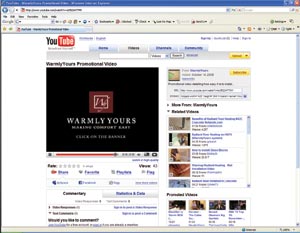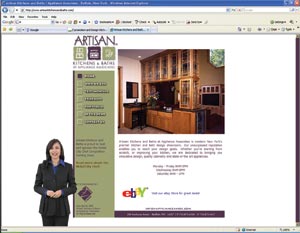
 |
|||||||
|
By Phil Zaleon While direct mail and Yellow Pages ads have long been marketing staples, technology has completely revamped how kitchen and bath firms view marketing. Indeed, today’s most important marketing tools are just as likely to include interactive Web sites, blogs, YouTube, social networking sites, podcasts and more, as some of the more traditional favorites. Changing demographics and attitudes, technological advances and a consumer mentality that demands instant access to information are key drivers of these changes. Yet marketing by technology is more than just a function of younger, tech-savvy consumers. A very old marketing concept – the importance of personalizing the message – has been essential to the evolution of technology as a marketing tool. CHANGING DEMOGRAPHICS In the 2007 report “Foundations for Future Growth in the Remodeling Industry,” published by the Joint Center for Housing Studies of Harvard University, researchers looked at the demographics of the “remodeling customer.” They found that, by the year 2015, slightly more than 45% of our customers will have been born during the ’70s, ’80s and ’90s. While a slight majority may still wake up in 2015 with the morning paper and coffee, the up-and-coming generations of customers are turning to technology, rather than the traditional media, for their information. Gen Xers and Echo Boomers (born in the 1970s-1990s) can attest to the fact that technology has shaped their world, their frame of reference and how they respond to messages – and therefore advertising. These people grew up in a world of hundreds of television channels, personal computers, the Internet, cell phones and other personal technologies. In addition, as these technologies became the norm, many of the Baby Boomers (born in the ’50s and ’60s) embraced them, creating a likely majority of kitchen and bath industry customers looking beyond traditional media for their news and information. The 2007 book, “Connecting to the Net.Generation: What Higher Education Professionals Need to Know About Today’s Students,” by Reynol Junco and Jeanna Mastrodicasa, cited a survey of 7,705 U.S. college students, which found this relationship between Echo Boomers and technology:
These statistics illustrate a shift in the communication paradigm. The communication channels we rely upon to reach Baby Boomers won’t work to reach their kids and those older individuals who have adapted to the new paradigm. Effective advertising was once about reaching people with a message over and over again so that they might act upon it if it were delivered often enough. We were complacent about being interrupted by “a word from our sponsor.” We eventually got a bit more sophisticated and only wanted messages that pertained to our demographic group. It was okay to be delivered a message as a male, aged 35-54, while listening to a classic rock radio station. And advertisers delivered the same messages over and over until we believed them. But now technology has changed the way we accept advertising. Today, effective advertising is about reaching the correct person at the correct time with the correct message delivered in the correct manner. We perform an online search, and expect immediate results. We decide to buy music or a movie; we can do so at our keyboards within a matter of minutes. Technology has changed the communication paradigm and our expectations. And no one understands this better than the generations that are growing up in the midst of it. For savvy kitchen and bath marketers, now is the time to embrace new technology and use its marketing power to reach your current customers, as well as those coming down the pike. A successful kitchen and bath marketer will develop an integrated marketing strategy designed to reach those embracing the latest technologies, along with the more traditional customer base. As Max Isley, CMKBD, president of Hampton Kitchens in Raleigh, NC says, “I am not ready to dump the traditional [marketing channels] for the latest technology. We use both to an extent and I can usually guess – with a high degree of accuracy – which was most effective in bringing in a [specific] new client. Our older customers respond to the more traditional messages in newspapers, the Yellow Pages and the like, while our younger customers are driven by the Internet and e-mails.” Mark Ergmann, president of Coastal Kitchen & Bath Designs in York, ME, adds that, “Generally, people who come to us from our Web site are five to 10 years younger than our average customer.” As an industry, we are taking baby steps employing new technology in our daily marketing. A look at some of the strategies and tactics implemented throughout the country may provide the spark you need to become more successful moving forward. ONLINE PRESENCE For kitchen and bath professionals, a Web site is a must, but it is only the beginning. The days of the standard “brochure” sites are quickly coming to a close, as your customers are looking for more. They want more information and more interactivity. Rob Baugher, JC, CGR, CGB, GMB, CAPS, CGA, owner and CEO of Baugher Design and Remodel in Birmingham, AL, has added an RSS Feed to his site. “RSS, which stands for Real Simple Syndication, is a way for my clients to ‘subscribe’ to my Web site. That is, as we update and add new material, those visitors who have signed up for RSS get a message with the new information and a link to the Web site. This has been a great way to keep my clients and potential clients informed and engaged.” Baugher also intends to add podcasts to his site in the near future. “We have a Saturday morning radio show on a local station. The natural progression is to place podcasts on the site – expanding our audience, and our reputation as remodeling experts, along with it.” Nicolas Mottet, advertising manager for WarmlyYours, manufacturer of electric floor heating systems, says that WarmlyYours has “always found the Internet to be among the most effective marketing channels for us. We recently invested in a proprietary Flash-based technology to let homeowners or designers design floor plans online and simply drag-and-drop predesigned fixtures into their plans. This tool has proven hugely successful as over 3,000 homeowners and designers use it every month to design their room, and get an instant quote on our electric floor heating systems.” Some industry professionals use the Internet as their primary selling tool. Matthew May, CKD, president of Cabinet Dynamics, is among them. “I found a way to not only sell cabinets and vanities online, but to use the power of the Internet to provide designer services, as well. It has opened up new revenue channels, unheard of just a few years ago,” he says. Kevin Telaak, v.p. of Artisan Kitchens and Baths of Buffalo, NY, uses eBay as an additional selling tool. “We set up an eBay store a couple of years ago to sell some appliances and overstocks, and it has become an integral part of our business, bringing in more revenue than we ever imagined. There are hundreds of thousands of eBay users out there, and having a store puts us at their fingertips – literally.” In addition, other developing and older technologies have found their place independently on the Internet, or as part of company Web sites. Mottet believes that the Web site experience is critical to a company’s success and, to that end, interactivity is a must. He states: “Our site has evolved into an interactive platform where visitors enjoy controlling their surfing experience and quickly accessing content that is relevant to them, delivered in an interactive and entertaining format. From online tools to videos and libraries of customer projects, our site delivers an interactive, relevant and personalized experience. We blog two or three new customer projects every month.” WEB 2.0 Just a few steps beyond a “typical” Web site is Web 2.0. Wikipedia explains, “Web 2.0 has numerous definitions. Basically, the term encapsulates the idea of the proliferation of interconnectivity and interactivity of Web-delivered content.” But, it also states, “Web 2.0 is a term describing changing trends in the use of World Wide Web technology and Web design that aims to enhance creativity, information sharing, collaboration and functionality of the Web. Web 2.0 concepts have led to the development and evolution of Web-based communities and hosted services, such as social-networking sites, video-sharing sites, wikis, blogs and folksonomies.” “We take the videos from our Web sites and place them on YouTube.com,” says Nicholas Mottet. “It is just one more place to reach the consumer. We are not getting thousands of viewings, but each viewer is potentially someone who didn’t know about us before.” Jamie Goldberg, AKBD, CAPS, owner of Jamie Goldberg Kitchen and Bath Design of Tampa, FL, uses blogging to keep her online content fresh and her name high on search engines. “My blog also allows me to keep in touch with my clients and vice versa. I write about industry shows, new trends, styles and innovations, all of which help me maintain a communication link with my current clients and prospective ones. It also allows me to build my reputation as a Tampa Bay area kitchen and bath expert.” “Social networking is not just for kids anymore,” adds Goldberg. “I am on LinkedIn.com and Twitter.com. I use LinkedIn for introductions, pitching articles, getting and making recommendations, finding out about resources through the Answers section, getting images to accompany articles and blog postings through e-mailing my contact list, staying in touch and, most recently, participating in the Group discussions feature. The groups have the potential to be invaluable, with a number of industry-related ones such as the NKBA group, the Kitchen & Bath Industry Marketing Group and Kitchen World, among others.” Dennis D. Gehman, CR, CLC, CKBR, GAC, CAPS, president of Gehman Custom Remodeling in Harleysville, PA, is investing in Web 2.0 with his soon-to-be released updated Web site. “Our new site is going to be heavily tied to blogs, YouTube, Facebook, MySpace, LinkedIn, etc. We are actively looking for a high school or college student who wants to earn extra money doing what he or she already enjoys. Our idea is to hire a student to maintain our presence on FaceBook, MySpace and the like through use of blogs, videos, photo albums and general updates. The cost to us will be minimal, students know what they’re doing [in this arena], and hours can be flexible. Our challenge is finding the right person willing to accept and adhere to our business/life values and philosophy in order to represent us in a professional manner.” Max Isley, CMKBD has a presence on LinkedIn, but has not yet exploited it to any extent. “I understand there is value to online social and business networking. I have always used networking – the old-fashioned, personal kind – in my business, I just have to get used to it through a keyboard and monitor. The value as I see it is to first build my network with peers and clients; then ask my network to recommend my work. As they build their networks, their connections will read my recommendations and hopefully will increase sales.” Among the other, more popular, networking sites not previously mentioned are Plaxo.com, Classmates.com, Twitter.com, Yahoo360 and ecademy.com. A Web search will provide a more complete list, which is likely to be updated often. Of course the newest technology is often tied to some of the oldest technology. Somewhere around 1455, the printing press was invented and book publishing was born. In the last few years, technology has allowed book publishing to be “reborn” through the advent of OnDemand publishing by companies such as lulu.com. OnDemand publishing allows an individual to publish without a traditional publisher or the associated expenses. For example, a kitchen and bath designer could publish a coffee table book of projects to use as a sales tool, for very little investment. Those who subscribe to cable and satellite are likely familiar with OnDemand programming – programming you watch when it is convenient for you. Along with the traditional cable networks such as HBO, Showtime, TBS, TNT, etc. offering OnDemand choices, many of the cable systems have “local channels” offering OnDemand, as well. A call to your cable representative may allow you to put your expertise on cable for your community to see. E-DATA DRIVEN Newsletters and direct mail have always been industry staples. Technology – specifically database and mail merge – has made it simpler and provided individuals with the ability to speak one-on-one with a cross-section of clients simultaneously with varying messages. Dennis Gehman uses his firm’s database for e-mail blasts. “We send monthly newsletters with photos of six to eight projects focusing on a specific type/element. We’ve found that the best way to grow our e-mail list is when clients forward the newsletter to their friends, family and co-workers because a picture of their project is featured. We have learned that the more projects per newsletter, the more it gets forwarded and the more new subscribers we get. It’s the consummate marriage of direct mail and networking – and it’s instantaneous and cheap.” WHAT’S NEXT? It’s a safe bet that no one could have imagined the iPhone in 2000, the Internet in 1980, TV in 1920 or the recorded voice in 1850 – but each technological advance changed the face of marketing and advertising in its day. What will change our ability to market our showrooms in 2009 and beyond is anyone’s guess. But those who are not willing to embrace the latest technologies as a part of their marketing efforts will be playing catch up as the next generation begins renovating their kitchens. As Jamie Goldberg explains, “I spent 25 years in media and marketing before becoming a kitchen designer, and have always been interested in new media. My last career was focused on leveraging content and brands across multiple media platforms. I’m applying the same strategies to my new career, as well. For example, if I’m presenting a design-related seminar to a local community group, I’m also going to create a newsletter article on that topic and blog about it online. Next, I’ll update the status line on my LinkedIn page and Twitter about my involvement with that subject. The combination creates a much greater ROI and broader reach for the time I spent developing the seminar.” ******** Philip D. Zaleon is founder and president of Chapel Hill-based Z promotion & design – a full service integrated marketing and creative agency focusing on the kitchen and bath industry. Prior to founding Z promotion & design in 1996, Phil held the position of v.p./research & development for a new technology-based communications firm. Phil is currently Vice President Communications/Technology for the Eastern Carolinas Chapter of NKBA, an industry speaker on marketing, advertising and technology subjects and author of "A is for Advertising... B is for Branding... a hands-on guide to improved profits through marketing your kitchen and bath business - volume 1". Z promotion & design is a member of NKBA and KCMA. He can be reached at Z promotion & design, P.O.
Box 17291, Chapel Hill, NC 27516; Telephone:
919-932-4600; Fax: 919-932-4447; |
|
||||||
|
copyright © 2009 |
|||||||
Buy Phil Zaleon's book, a marketing guide specifically written for the kitchen and bath professional

Click the cover to purchase your copy.
|
From time to time, we interview Kitchen and Bath
Professionals for articles, market research and opinions, if you are
interested in submitting your name to our database, follow the link
below. |
Take a Break with a game of
Tic-Tac-Toe
| ABOUT US | CONTACT US |
HOME | ABOUT US | SERVICES | PORTFOLIO | Zpd.TIPS | KITCHEN MARKETING BLOG | SITE MAP



